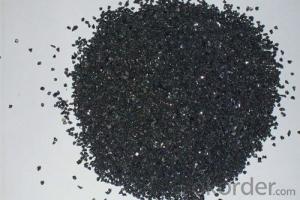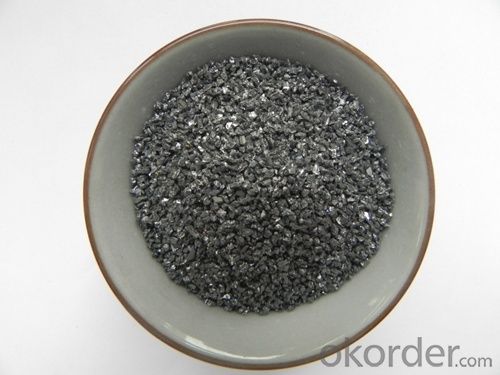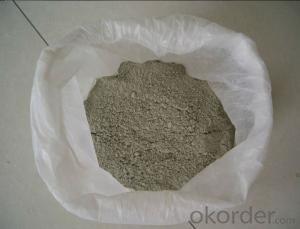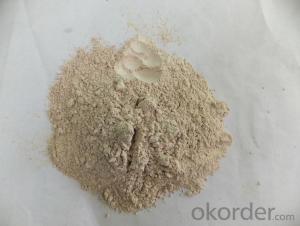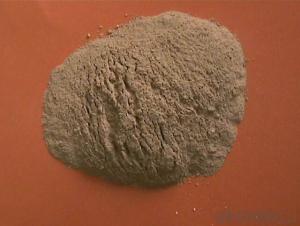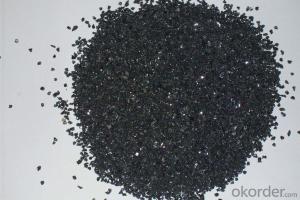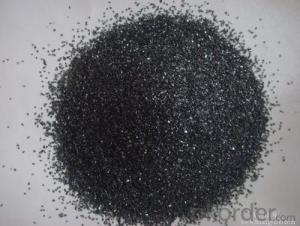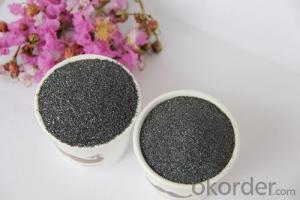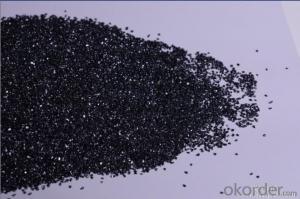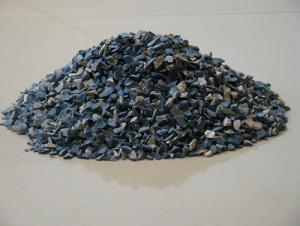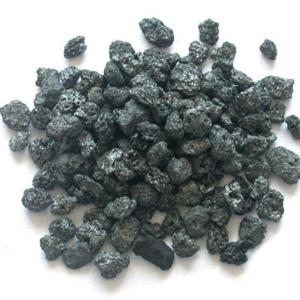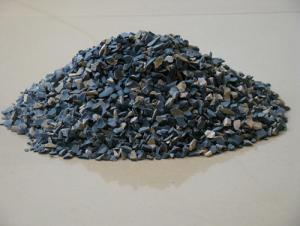Raw Materials for Refractory:Sic >98% F10-F1600 Black Silicon Carbide for Refractory & Abrasives by CNBM
- Loading Port:
- China main port
- Payment Terms:
- TT OR LC
- Min Order Qty:
- 25 m.t.
- Supply Capability:
- 2000 m.t./month
OKorder Service Pledge
OKorder Financial Service
You Might Also Like
Packaging & Delivery
| Packaging Details: | 25kg/bags , jumbo bags for black silicon carbide |
| Delivery Detail: | within 15 days of black silicon carbide for refractory |
SIC >98% F10-F1600 black silicon carbide for refractory&abrasives
Product Description
Black Silicon Carbide is produced in a high temperature electric resistance-type furnace from a mixture of quartz sand and petroleum coke.
The hardness of black silicon carbide is greater than fused alumina but less than synthetic diamond.
Its mechancial intensity is greater than fused alumina, but is brittle and very sharp. The mineral has some electrical and heat conductivity.
Black silicon carbide is typically used for machining or finishing cast iron ,non-ferrous metals, stone, leather, rubber, and other materials where sharp cutting characteristics are important .
Black Silicon Carbide is brittle and sharp and has electrical and heat conductivity in some degree.
Aplications :
Black Silicon Carbide is suitable for make grinding wheels, cutting wheels, mounted wheels, oil stone, abrasive media, and also suitable for surface grinding, lapping or polishing.
The abrasive products made of it are suitable for working on Cast Iron, Non-ferrous Metal, Rock, Leather, Rubber, Wood, Ceramic, etc.
Black Silicon Carbide is also broadly used as high-grade refractory material and metallurgical additive.

- Q: who knows the requirements of refractory for forge furnace?
- Requirements are as follows: 1, it should have enough refractoriness and softening point under a fixed load. Because under the effect of electric arc, inner surface temperature in different parts of furnace lining can reach 1500 ~ 1800 ℃. 2, it should have strong slag resistance. Because slag and smoke at high temperature penetrate through furnace lining to its internal lining, causing the melting of refractory, organization stratification, and even peeling?off. 3, it should have good thermal shock resistance. Because in the process of steelmaking, openning the oven door and lifting the furnace lid will make temperature of refractories in the furnace lining change rapidly, it might happen peeling?off and cracking, causing the premature failure of furnace lining. 4, it should have sufficient strength, because the furnace lining will be shocked when being loaded, vibrated when being tilted, scoured by metals,molten slag and air flow when boiling. 5, smaller thermal conductivity, lower electrical conductivity. Commonly used refractories for electric furnace include magnesia bricks, dolomite brick, high alumina refractory brick, siliceous refractory brick and magnesite ramming material,etc. owing to the different work environment of each part of the furnace,refractory used by each part is also different.
- Q: What refractories are used in various parts of the blast furnace.
- Blast furnace from top to bottom has the throat, hearth staves, waist, bosh, hearth and furnace bottom. the specific structure is as follows: The throat is the first to be affected by the impact and abrasion, generally use high-density alumina bricks. the upper and central portion of temperature furnace is only 400 ~ 800 ℃, the area with high alumina bricks and silicate bricks. The lower part of furnace is subject to erosion and dust erosion alkali metal vapor due to high temperatures, it is required in such case to use high quality clay brick,high alumina brick,carborundum brick,corundum brick that is slag resistance and alkali?resistance, temperature resustant and wearproof. Furnace bosh temperature reached 1400 ~ 1600 ℃, serverly eroded by slag,vapor, flush. so we use carborundum brick and reaction-bonded silicon?carbide?brick. Bosh temperature reaching1600 ~ 1650 ℃, using alumina brick, corundum brick or silicon carbide brick. the temperature of Hearth near the upper portion of the outlet zone at 1700 ~ 2000 ℃, use of silicate bricks and corundum castable graphite filler, silicon carbide bricks. In 1450 Silly twitch bottom temperature sealing die of hunger slander bet phoenix astringent preserved Grade ~ 1500 ℃, use of graphite bricks and microporous carbon bricks, now use more corundum brick, corundum mullite brick and synthetic mullite brick. x26lt;P class x3d "share-btn"x26gt;
- Q: What is the concept of lightweight refractory material?
- Lightweight refractory material has high porosity, mechanical strength and erosion resistance. Compared with normal refractory bricks, it is a kind of refractory material with large volume shrinkage in high temperature, low thermal conductivity and small bulk density. It is used as thermal insulation material in industrial furnace and other thermal equipments. It has poor wear resistancel.
- Q: What are the differences and connections between softening temperature of the refractory under a fixed load and thermal resistant creep property of the refractory?
- The result of refractoriness under load is temperature while the result of creep is percentage of deformation. Refractoriness under load and creep can be tested by an instrument. Refractoriness under load reflects the temperature in which the deformation reaches a certain degree under the condition of load. Creep reflects the deformation refractory has under the condition of constant temperature and load. Both refractoriness under load and creep are important criterion for the operating temperature of refractory.
- Q: I wanna ask what are the acidic refractories?
- You can look at these: (1) silica?brick with stronge acidity, unshaped silicious refractory, quartz glass and fused silica combined products; (2) semi-silica refractory with moderate acidity and pyrophyllite refractory; (3) clay-based refractory with weak acidity. I hope it is useful!
- Q: What are the differences of ceramics and refractories? Is the ceramics belonging to refractories?
- They are not the same. If you say the ceramic fibers, they have some common points because the ceramic fiber is one of the refractory. It is belonged to the lightweight refractory which can be considered a new type of refractory with the main ingredient of aluminum silicate (including aluminium oxide and silicon?dioxide).
- Q: I am a refractory material manufacturer, sold products, money is always not back, anxious to die, what is the way?
- Many manufacturers are facing the same problem, difficult to find the order, order the payment contract is more difficult, it is difficult to have binding, the better solution is to seek third party secured transactions, see the whole production or see full delivery
- Q: Are the rubber insulation materials are refractory materials?
- No
- Q: Which fireproofing materials factory is the best in Xiangyang?
- Of course, it is "Lvchuang Construction Energy Saving Engineering Co., Ltd." in Xuzhou, which main products are A-level fireproofing thermal insulation boards. It has many projects. B1-level fireproof materials are polyphenyl boards, extruded sheets, phenolic foam boards, Polyurethane board, sea capacity building energy efficiency module. Flame retardant has been added to the sea capacity building energy efficiency modules which has a B1-level fireproofing performance. You can also add expanded glazed hollow beads to them if you are worried about the security.
Send your message to us
Raw Materials for Refractory:Sic >98% F10-F1600 Black Silicon Carbide for Refractory & Abrasives by CNBM
- Loading Port:
- China main port
- Payment Terms:
- TT OR LC
- Min Order Qty:
- 25 m.t.
- Supply Capability:
- 2000 m.t./month
OKorder Service Pledge
OKorder Financial Service
Similar products
Hot products
Hot Searches
Related keywords
